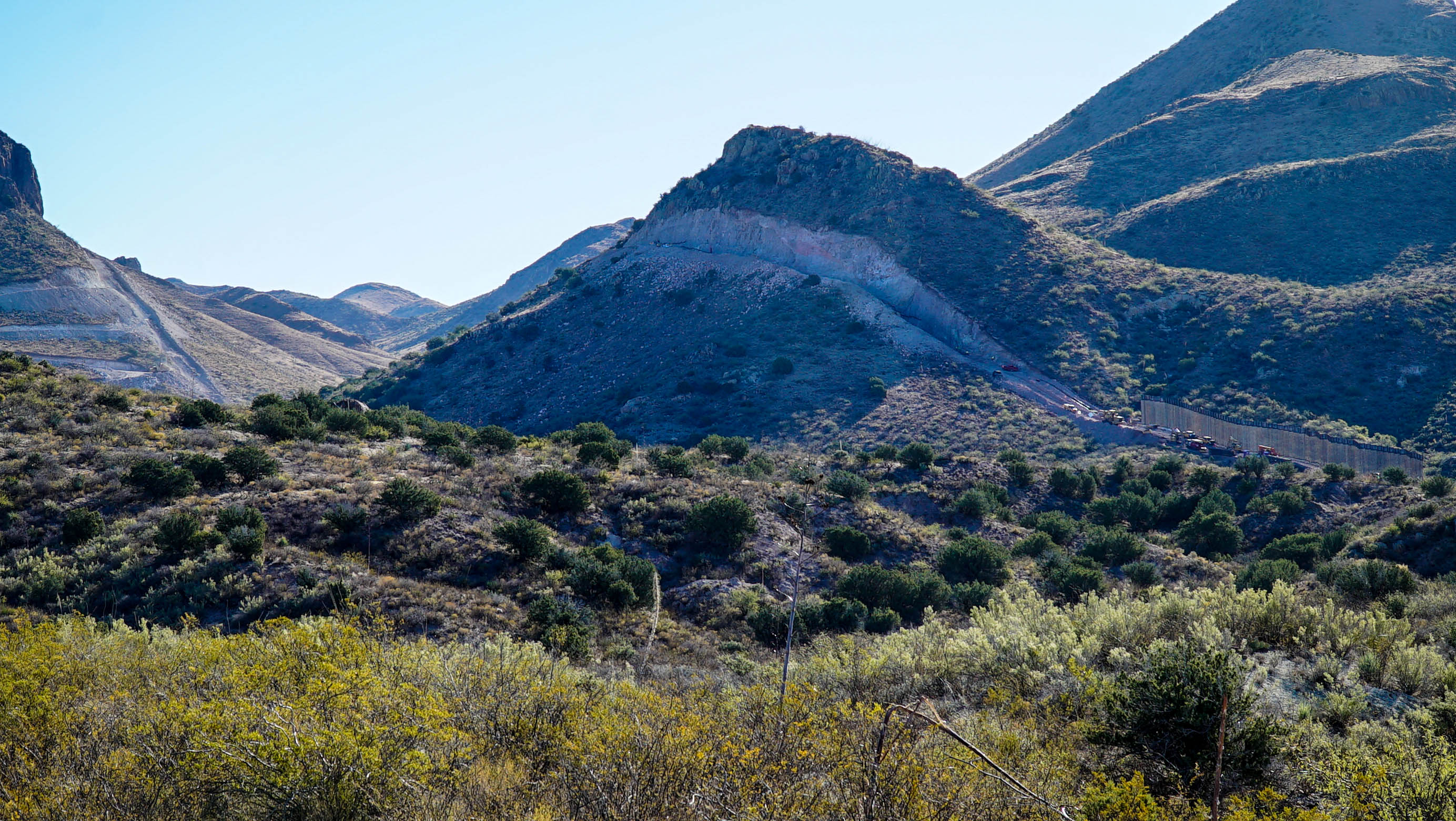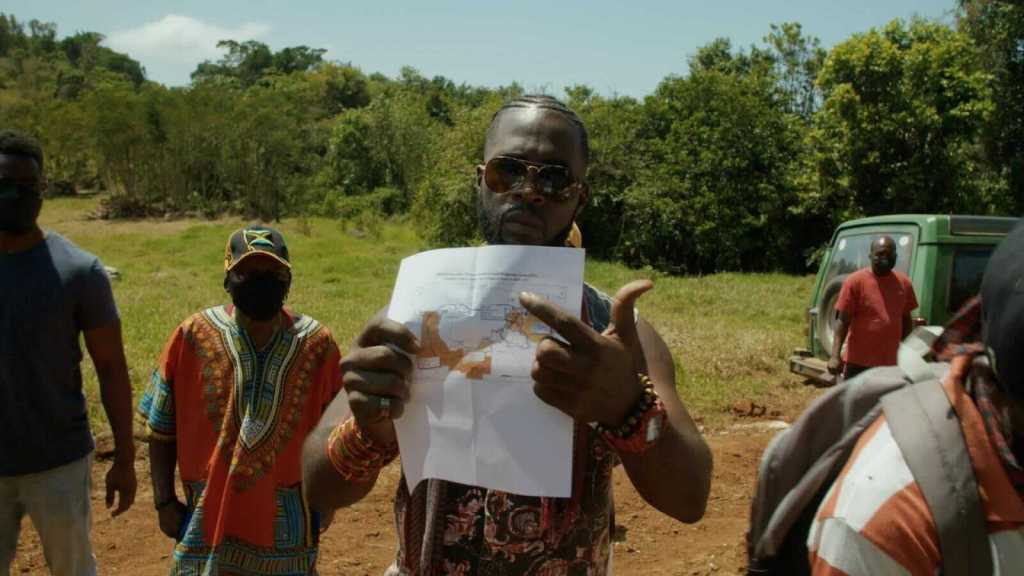CHUKUT KUK, Tohono O’odham Nation—Kendall Jose stands next to an old metal fence that crosses through the traditional homelands of the O’odham people and represents a border designated long ago by the governments of the United States and Mexico.
Construction crews were working at breakneck speed to complete hundreds of miles of border wall during President Donald Trump’s final months in office, but here the “wall” is still just periodic metal poles a few feet high or criss-crossing vehicle barriers that could, theoretically, allow the passage of people. But more important to the Tohono O’odham Nation, it includes one of the last remaining highways for threatened and endangered species.
Videos by VICE
The peaks and valleys that transcend Arizona and Sonora are considered the most biodiverse inland area on the entire continent and habitat for animals like jaguars, mountain lions, and black bears that had long previously lived in harmony with native populations like the O’odham.
For four years, the Chukut Kuk district of the Tohono O’odham Nation that controls 52 of the nation’s 62 miles of border territory, managed to stave off wall construction on their territory in exchange for increased border patrol and surveillance technology, making it one of the last remaining portions of the Arizona border that has yet to see construction. Construction to the east and west of their lands devastated the local wildlife as well as a number of sacred sites that are outside their remaining territory, which Jose, the vice chairman of Chukut Kuk, calls “disheartening.”
“We got to allow nature to take its course, the animals to be able to cross back and forth, water to flow,” he says. “It was very important for the people here that we continue to coexist with nature, as has been taught by our history. From our very creation stories and the stories thereafter, they taught us how to coexist with Mother Earth, how to have respect for the land. Again, that we are not here on our own.”

On Jan. 20, U.S. President Joe Biden signed an executive order to immediately “pause” border wall construction for 60 days while reviewing the administrative and contractual consequences of ending construction. Experts have suggested that canceling existing contracts could be costly and result in legal consequences, while others disagree.
Arizona Congressman Raúl Grijalva hopes not only that the wall won’t be paused, but also that the existing wall will be brought down.
“The Biden administration must institute a permanent moratorium on all border wall construction and cancel all existing border wall construction contracts,” he said in a statement to VICE News. “In places with significant environmental damage, the wall should be torn down and the habitat restored. It’s the right thing to do.”
The White House did not respond to requests for comment.
In the meantime, activists say construction has continued despite the order.
“It’s a real mess here at the border, with a lot of construction activity since January 20,” said Emily Burns, of the conservation organization Sky Island Alliance. The nonprofit tracks border wall construction and has detected a number of active building points in Arizona, along with a few in California and Texas. “There’s a lot of confusion.”

Critical migration route
To understand how animals moved before the wall, it helps to look at the largest stretch without one: the San Rafael Valley, which lies to the east of the Tohono O’odham Nation and at the bottom of the Sky Islands, a vast area of connected mountain ranges that cross the United States and Mexico.
The region has long been a critical migration route for a number of species like ocelots, mountain lions, and black bears, and has also been the home of binational efforts to restore endangered species like jaguars, Mexican wolves, and bisons. But seeing how construction in the final months of Trump’s presidency cut through the area, conservationists are concerned about the unknown long-term effects.
Sky Island Alliance has been running a camera research program to track animal species in the San Rafael Valley, and for the past months, Burns says, they’ve been on “pins and needles” that construction could continue there, one of the final places where animal species can pass.
“This is sort of a continental scale experiment to understand what’s going to happen to wildlife populations when they’re completely split and separated,” says Burns.
One of the clearest points separating the San Rafael Valley and the Sky Islands is the lookout point at Coronado Peak. Paulo Quadri Barba, the conservation director for Sky Island Alliance, stands at the top, looking out at the untouched San Rafael Valley to the west and a long stretch of wall jutting into the Sky Islands to the east. He compares the wall to a “scar” that now blocks what has long been a “freeway” for animals.

“This place is famous, and it’s important because of the wild evolutionary and natural history it has. And it’s a history of connectivity and isolation between these mountains. But the fact that these animals have been able to move back and forth for thousands, millions, of years and now, there’s that thing there, it doesn’t make any sense,” he says.
Border wall construction in eastern and western Arizona has created a bottleneck for species, forcing them into the remaining open portions in the center of the state in the San Rafael Valley and the Tohono O’odham Nation. That could lead to a variety of unknown consequences, from migration and mating patterns, to throwing predator-prey relationships out of whack. It could also potentially eliminate endangered species who might not be able to survive the change—around 90 endangered and threatened species call the area home.
“We can’t leave just this bottleneck here as the only way for wildlife to move through. You know, that’s going to be catastrophic,” says Quadri Barba. “I think if we talk about serious restoration, yes, the wall needs to be removed.”
It hits Quadri Barba especially close to home. He grew up in Mexico and previously worked in the country’s national parks service, and has spent the past 10 years living in the U.S., so just like the animals, “both places are home.”
“It is pretty sad. But I’m not hopeless,” he says. “I think both Mexico and the U.S. together, they’ve done great things to overcome past mistakes in history. And I don’t think this will be an exception, but it will take a lot of political will and a lot of people standing on the right side to restore this place.”
So far, that hasn’t happened in either the U.S. or Mexico.

A ‘bottleneck’ for wildlife
The construction of the border wall has cut through a number of conservation ranches run by the bi-national organization Cuenca Los Ojos A.C leading into the Sky Islands. The organization’s director on the Sonoran side of the wall, José Manuel Perez Cantú, is disappointed by the Mexican government’s unwillingness to try to stop the border wall construction that ravaged the area in the past year.
“The Mexican government has a policy of non-intervention. So there hasn’t been any sort of complaint, any sort of intervention on behalf of the Mexican government towards the United States,” says Pérez Cantu.
Mexican President Andrés Manuel López Obrador has largely remained silent on the construction of the wall since taking office in December 2018. When asked last July about the ongoing building by local journalists after meeting with Trump, López Obrador stated that he didn’t “have an opinion” on it. Over the past two years, López Obrador became an unlikely ally of Trump on many issues and especially migration. Beyond remaining silent on border wall construction, López Obrador also stepped up law enforcement’s response to stopping migrants on Mexico’s southern border and as they traveled north through the country.
That leaves Perez Cantú hoping that with Biden in office, maybe he’ll be the one to make a change.
“We hope that with the new administration on the American side there will be more open portions of the wall, that we can create wildlife crossings through this wall that allows the passages between the two nations, so that the flow of wildlife that historically passed through here can benefit.”
Perez Cantú, around 6 feet tall, looks tiny next to the 30-foot-high barrier as he pulls out his measuring tape to show how close together the steel beams are, and laments that few animals would be able to pass through such a small gap. Cuenca Los Ojos A.C runs a number of conservation programs tracking the effect on wildlife on the Mexican side that can no longer move across the border.
“This horrible wall, that’s cutting off all these biological riches, the migration of wildlife,” he says. “[The wildlife] is going to be drastically affected by the construction of this wall.”
He follows a set of animal prints that led to a number of flood gates in the wall and explained how it was the final gate to be closed on that ranch.
“You can see how wildlife discovered it and used it as a little corridor to pass through,” he says. “It’s not people who are using it; it’s used by wildlife. We want the new administration to understand the importance of having these biological corridors open, and the possibility of having it monitored with cameras or in some way, and that this would allow the wildlife to continue to pass.”

Directly on the other side of that portion of the wall is the San Bernardino National Wildlife Refuge in Arizona. Myles Traphagen, a conservationist with Wildlands Network, also examines the floodgates, noting that they are welded shut. He sarcastically wonders how they would open them if there ever was a flood.
It’s still unclear exactly how many floodgates exist along the border wall, but for Traphagen, opening them would “be a pretty easy, immediate solution. At least we’d stop the bleeding and the wildlife can pass back and forth until we come up with some other solution, the political will to take these walls down.”
Traphagen runs a separate camera research program in the wildlife refuge, and since the wall’s construction there in 2020, he’s noticed a disturbing effect on animal species, and specifically larger creatures like mountain lions, as they encounter the barrier.
“You’ll see this at zoos, you’ll see a lot of pacing along the walls.”
“You’ll see this at zoos, you’ll see a lot of pacing along the walls,” says Traphagen. It’s an indication of stress and confusion from the animals as their natural habitats are thrown out of kilter.
This is just one of the immediately visible effects of the wall in what he calls the “meeting ground of major elements of western North America.”
“People sometimes think that, oh, this is the border, but in fact, this is the heartland of the North American continent because you find a little bit of everything here. It’s the only place where the jaguar and the black bear share the same paths, walk the same canyons,” says Traphagen. “It’s an evolutionary highway.”
Back in Chukut Kuk, Kendall Jose calls the notion that the government had the right to build such a large structure that affected animals in areas that the O’odham and other Native American groups have called home for millenniums, “a Western idea of thinking.”
“For the O’odham people, and I think for Native people in general, we don’t own the land; we’re caretakers of the land,” he says, noting that while he and his ancestors have been able to adapt as the times have changed, “the animals don’t have that luxury because they just go follow nature.”
“So the animals have to be able to freely do that. And if they can’t, we’re setting them up to fail.”







